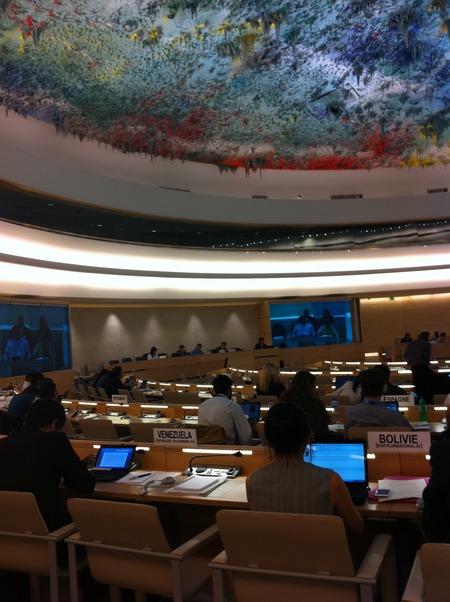
In July 2013, members of the United Nations Expert Mechanism on the Rights of Indigenous Peoples (EMRIP), along with representatives of States, Indigenous Peoples, NGOs, human rights institutions, academics and UN Bodies gathered in Geneva, Switzerland, at the Sixth Session of the Expert Mechanism on the Rights of Indigenous Peoples. The five-day session convened around several discussions that endorsed the Alta Outcome Document as the official document for the 2014 World Conference on Indigenous Peoples; addressed the implementation and accountability of the UN Declaration on the Rights of Indigenous Peoples by states; proposed that the rights of Indigenous Peoples and the Expert Mechanism be firmly incorporated in the post-2015 UN Development Agenda. A core agenda item of the meeting was to follow up on the current study Access to Justice in the Protection and Promotion of the Rights of Indigenous Peoples and identify and propose next year’s thematic study.
The Expert Mechanism on the Rights of Indigenous Peoples is a critical and needed body to conduct research and assessment. It was established by the UN Human Rights Council in 2007, to advise the Human Rights Council on studies and research that effect the rights of Indigenous Peoples. The Expert Mechanism has thus far conducted studies on Indigenous Peoples’ right to education, the right to participate in decision making, the role of languages and culture in the promotion and protection of the rights and identity of Indigenous Peoples, and best practices on appropriate measures and implementation strategies in order to attain the goals of the United Nations Declaration on the Rights of Indigenous Peoples.
In particular, in 2012, the Expert Mechanism completed a study on Indigenous Peoples’ access to justice in the promotion and protection of the rights of Indigenous Peoples. The “gravity of the issues facing Indigenous Peoples, including discrimination against Indigenous Peoples in criminal justice systems, particularly for Indigenous women and youth” was highlighted. This is evident by the overrepresentation of Indigenous people in incarceration in regions around the world. In Australia Aboriginal people total 2.3 percent of the population, yet make up over 28 percent of Australia’s incarcerated population. In Canada, First Nation’s people total 4 percent of the population, yet make up 23.2 percent of the incarcerated population. In the United States, states with high Native populations have correspondingly high Native American incarceration rates. Because of the importance and complexity of access to justice and the issues involved an extension of this study was proposed.
The Universal Declaration of Human Rights declares that “everyone has the right to an effective remedy by competent national tribunals for acts violating the fundamental rights granted to him by the constitution or by law.” The UN Declaration on the Rights of Indigenous Peoples further asserts the right of access to justice, articulating Indigenous Peoples’ rights to develop and maintain their own customs, traditions, and judicial systems. The right of access to justice is predicated on human rights and thus determines that “access to justice cannot be examined in isolation from other human rights issues, including structural discrimination, poverty, lack of access to health and education, and lack of recognition of rights to culture and lands, territories and resources.
Speaking at the 6th EMRIP Session, UN Special Rapporteur on the Rights of Indigenous Peoples, James Anaya made a link clear between the structural dimensions and historical context that must be taken into account when trying to increase access to justice for indigenous peoples. Through his own work, Anaya has seen firsthand how Indigenous people are harmed by justice systems external to their own, mainly the State justice system, a system very different from Indigenous models. In addition, the State justice system presents other obstacles for Indigenous peoples including the lack of financial resources for adequate legal representation, a lack of access to justice systems in remote areas, and inadequate provision of culturally appropriate justice services, including translation services. As such, the access to justice study concludes and recommends that States take a “rights-based and culturally appropriate approach to public safety and access to justice guided by Indigenous Peoples’ laws and justice systems.” The study also calls for the training of law enforcement and judicial officials on Indigenous Peoples’ rights. The use of transitional justice mechanisms, such as truth commissions, which allow for administration of justice through prosecutions, truth-seeking, reparations programs, institutional reforms was also endorsed. Anaya noted that a “flexible approach” was needed when it came to access to justice, one that increased respect for Indigenous Peoples’ own justice systems in both of recognizing and assigning value to these systems. Anaya also noted that, “state responses that limit Indigenous control run the risk of undermining Indigenous self-determination and have been shown to be less effective long-term solutions, generally speaking, in comparison to judicial responses to problems that Indigenous Peoples themselves control.”
“The Expert Mechanism on the Rights of Indigenous Peoples provides critical study and analysis of the human rights violations Indigenous Peoples suffer and the systematic failure of states to uphold these human rights. Importantly, the study and analysis is done by Indigenous people who assert traditional and cultural based Indigenous thinking and frameworks; who demand state accountability, and make recommendations based on human rights and Indigenous Peoples rights to self –determination, “ says Suzanne Benally, Executive Director of Cultural Survival.
